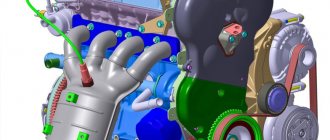Personal vehicles have become an integral component of the life of every third modern person. However, in addition to comfort and convenience, car owners are faced with a number of additional difficulties that arise during the operation of vehicles: system maintenance, replacement of components, cost of refueling. It is thanks to the regularly rising prices for gasoline that many motorists equip their cars with gas equipment, which can significantly reduce the cost of travel. Installing LPG costs owners large sums of money.
Having caught the trend towards growing consumer demand for biofuel systems, domestic manufacturers have created a modified Lada Vesta model, the distinctive feature of which is the ability to use two types of fuel at once: gas (methane) and the usual gasoline.
The characteristics of the Lada Vesta CNG will be discussed in more detail below.
What are the advantages of the methane version of Lada Vesta
The first samples of the modified car were presented by the plant in mid-2014 and caused a sensation due to the presence of a foreign-made factory gas installation and the possibility of using two fuel systems. Mass production of the model range started only in 2022.
The advantages of the methane version are:
- bringing the toxicity level to international standards;
- significant reduction in fuel costs (subject to the use of gas equipment);
- increasing the travel distance to 1000 km on a full tank;
- greater safety of methane compared to propane and butane;
- less wear of power plant mechanisms.
One of the main advantages, of course, is considered to be efficiency, especially when it comes to regular use of the car and driving long distances. This model has no external differences from the previous version, except for special markings in the trunk area, indicating that the car uses methane. Convenient for daily use, front-wheel drive sedans and station wagons are distinguished by a slightly higher price due to the dual-fuel system. However, economical fuel consumption and a lower price for methane offset this fact.
What is the difference between propane and methane. The principle of operation of a methane engine
Propane and methane are gas-fuel substances that have the same purpose, but fundamentally different characteristics. Propane is a product of the oil industry, while methane is classified as a natural gas. When used as fuel for HBO, both gases are placed in cylinders, the thickness of the walls of which also depends on the substance for which they are intended.
Liquefied propane does not require excessively high pressure when filling the cylinder; accordingly, the walls of the propane storage are not too dense (4-5 mm). Methane is used only in gaseous form, and its pressure reaches extremely high levels. Methane cylinders are much larger in size, their walls are strong (2-3 cm). During combustion, methane is harmless to the environment, which is why it is recognized by world standards as the most environmentally friendly combustible fuel. The most important difference between the two categories of gases is the degree of their safety for the driver and passengers of the car. Methane, unlike propane, is light, which allows the substance to evaporate (if it leaks) before creating an explosive situation. Since methane has no color or odor, the gas is diluted with specific odorants that make it possible to identify a leak. In Russia, the lion's share of car owners prefer installing propane gas equipment due to its lower cost and the relative lightness of fuel cylinders. Methane equipment is much more expensive, but the price of methane, its environmental friendliness and operational safety cover this disadvantage. A methane engine operates on the same principle as a gasoline engine (the compressed mixture is ignited by an energy source) with one fundamental difference - an increased level of compression. The source of fuel supply is a gas cylinder, which is installed in the trunk of the car and is equipped with a special valve, through which both the equipment is refueled and gas is supplied to the system.
Lada Vesta 2019-2020 owner reviews
- Review
- Prices
- Characteristics
- Photo
- Video
- Reviews
All the disadvantages of Lada Vesta 2019-2020
➖ Crickets in the cabin ➖ Slow acceleration (regarding the version with the 1.6 engine) ➖ Bad wipers
pros
➕ Spacious and comfortable interior ➕ Nice design ➕ High ground clearance ➕ Good handling ➕ Price
The pros and cons of the Lada Vesta 2019-2020 were identified based on reviews from owners who own cars with high mileage. More detailed advantages and disadvantages of the Lada Vesta 1.6 and 1.8 sedan with mechanics, AMT robot and automatic transmission can be found in the stories below.
Reviews
Initially, when starting the engine, the wipers operate once. It seems like nonsense, but not for winter. Also, when starting, the engine seems to “sag”, something goes somewhere. I lost 2 days in the company’s service, they couldn’t understand or fix anything, everything is written off to the factory. When yesterday I spent the last 10 hours in the service center, waiting for what was about to happen, I began to speak in understandable Russian jargon.
My masters completely dismantled and reassembled old cars in such a time. There’s a new car and here’s the problem. We haven't encountered this with others. Conclusion: either again everyone is doing it in Russian, or the servicemen are without heads and hands. I've owned the car for less than a month, it's just a shame. I will wait for the result."
Sergey Morozov, review of Lada Vesta 1.6 (106 hp) MT 2018.
Video review
Recognizable design. Finally, Zhiguli cars have such an appearance that you want to buy them. Vesta's handling is excellent, there is good ground clearance, the headlights are adjusted correctly - they illuminate the road decently. I have no complaints about the interior. Except that I would have arranged the air flow direction buttons differently.
On mine, already at 5,000 km, the stabilizer struts began to rattle and this problem is widespread. Noise insulation is tolerable, but it could be better; at speeds of 100 km/h, air currents begin to be very audible.
The heating control system is poorly configured. The display on which the heating level is adjusted has 15 (I think) divisions. So, the car will be warm only starting from the 12th division, even from the 13th. In other words, in winter there are two modes: the first 12 divisions are cold air, the last 3 are hot.
The front seat headrest is very disappointing, it is so bad that I want to throw it out, but driving without it is much more pleasant. No matter how you adjust it in height, it does not allow you to lean your back on the chair. He stupidly tilts his head forward so that after a long trip his cervical spine hurts. The seat in the chair is not large: it is short and narrow, so for me, being 180 cm tall, it is not very comfortable to sit.
Technical characteristics of Lada Vesta on methane
Lada Vesta CNG is equipped with a 1.6 liter dual-fuel engine and a five-speed manual transmission. The maximum speed when using gasoline is 175 km/h, gas - 170 km/h. The power of the power plant when driving on gasoline is 106 kW. When switching to methane, the figures drop to 96 kW.
The gas fuel refill compartment is located directly behind the gas tank hatch. The modified version of the car is equipped with a factory-installed Italian-made gas system; a 90-liter gas cylinder is located behind the rear seats. To increase the safety level of the tank, the cylinder is equipped with high-speed valves and a special fuse that prevents it from rupture and methane leakage. This arrangement of the volumetric cylinder significantly reduced the available space in the luggage compartment and made it impossible to transform the rear row of seats. Significant advantages were the absence of the need for maintenance of the gas reducer, fuel rail and the long service life of the cylinder (15 years). When ignited, this model uses exclusively gasoline fuel, after which the vehicle automatically switches to gas. Manufacturers have provided another important automated process - switching from gasoline to methane, in the case of the end of the former in the tank. The Lada Vesta functionality includes the ability to manually switch work from gasoline to gas and vice versa. The car accelerates to a speed of 100 km/h (when using gasoline) in 11.8 seconds. methane slightly increases these figures to 13c. The average methane consumption is 6.3 m3. Otherwise, the modified model is no different from its predecessor.
Dimensions
| № | Positive |
| 1. | Gennady (otzovik.com): the model’s dimensions are standard: 4410 / 1764 / 1497, wheelbase width 2635, as in previous modifications. |
| 2. | Vladimir (https://zr.ru): in dense city traffic it is sometimes difficult to change lanes, but I have already adapted. |
| 3. | Sergey (autobann.su): the dimensions of the car are average, a typical class “B” car. |
| 4. | Vladimir (lada-vesta.net): Vesta is no wider than Grants or Priors, so it won’t be difficult to handle on the highway. |
| 5. | Dmitry (otzovik.com): the car is just right for driving through city traffic jams, compact, economical, ergonomic. |
| 6. | Semyon (https://zr.ru): I use LadaVesta myself and recommend it to others. |
| 7. | Mark (autobann.su): for a small family of four - just right. |
| 8. | Georgy (lada-vesta.net): I bought a LadaVesta two years ago, I’m still happy with it, I don’t regret it. |
| 9. | Stepan (otzovik.com): compactness was one of the main factors for me when purchasing the LadaVesta. |
| 10. | Vladimir (https://zr.ru): a decent budget domestic car. |
| 11. | Alexander (autobann.su): my recommendations for car enthusiasts, the model is good, practical, small in size. |
| 12. | Mikhalych (https://forumvesta.ru): a gas installation combined with a small size is just right for urban use. |
| 13. | Vitaly (lada-vesta.net): after a year and a half of operation, the opinion is positive, there were no major breakdowns. |
| Negative | |
| 14. | Konstantin (https://zr.ru): externally the car is huge, but there is not enough space in the cabin. The parking lot is difficult to maneuver. |
| 15. | Vitaly (otzovik.com): the sloping rear window limits the visibility area, making it extremely difficult to back up. |
| 16. | Grigory (autobann.su): In Grant, visibility was better implemented. |
Related link:
Installation of fog lights on Lada Vesta. Tips and tricks from the experts
Prices and modifications of Lada Vesta on methane
At the present stage, the methane Lada Vesta is available in the following trim levels:
Classic - the basic version is equipped with two airbags, anti-lock braking system, electronic dynamic stabilization system, climate control equipment, electronically adjustable heated exterior mirrors, 15-inch metal wheels, brake force distribution system, electronic cruise control, traction control, hill start assist system , heated driver and passenger front seats. The price of the basic configuration starts from 600 thousand rubles.
Comfort - manufacturers have added a number of additional functions to the basic configuration: expanded ability to adjust the driver's seat, parking sensors, and a fairly powerful audio system. The price of the modification is about 640 thousand rubles.
The Luxe version includes power windows for the rear windows, additional side airbags, and sensors that respond to light and rain. Among other things, the version is equipped with alloy wheels with a diameter of 16 inches. For this modification, manufacturers ask from 700 thousand rubles.
Luxe Multimedia is the most expensive modification (from 730 thousand rubles). This version is equipped with a built-in navigation system, a 7-inch touch screen, six high-quality speakers, and multifunction steering.
Power reserve, gas consumption, cost of methane at gas stations
Thanks to the rather significant volume of the gas tank (55 l) and gas cylinder (90 l, 20-21 m3 of gas), the Lada Vesta is able to cover long distances without refueling, which is an excellent advantage for traveling long distances. On average, a vehicle can travel up to 400 km on a full gas tank, and about 1000 on a full gas tank.
Fuel consumption is directly related to the operating conditions of the car:
- in the urban cycle, Lada Vesta CNG consumes about 10 liters of gasoline and 8 liters of gas;
- in the suburbs, the figures vary from 6 liters (gasoline) to 5 liters (gas);
- with a mixed car it will consume 7.5 liters per 100 km driving on gasoline, 6.5 liters on methane.
The efficiency of the vehicle is undeniable, because the price of methane is significantly lower than its opponents (propane and gasoline). At gas stations in Russia, the cost of natural gas varies from 13 to 18 rubles.
Fuel
| № | Positive |
| 1. | Vitaly (otzovik.com): The gas cylinder reserve is enough for 290 – 300 km, depending on the speed limit. Gas consumption based on 6.3 cubic meters in a combined cycle. |
| 2. | Kirill (https://zr.ru): gas consumption is average, you could reduce your appetite. On the 21179 motor there is enough power reserve. |
| 3. | Dmitry (autobann.su): I don’t always pull the engine uphill in fifth gear, I often switch to fourth or third. |
| 4. | Ivan (lada-vesta.net): gas consumption is average, range is 300 km. |
| 5. | Vasily (otzovik.com): I mostly drive on gas, there’s enough power. I use gasoline extremely rarely, at startup. |
| 6. | Nikolay (https://zr.ru): There is enough power reserve on gas, but the cylinder takes up 2/3 of the luggage compartment, there is no room for things at all. |
| 7. | Sergey (autobann.su): my comrades replaced the standard cylinder, set it to 120 liters, the range increased by 30 - 45 km. |
| 8. | Vladislav (lada-vesta.net): gas allows you to significantly save on fuel, although not 42%, as stated by the manufacturer, but 30 - 35% is quite realistic. |
| 9. | Mikhalych (otzovik.com): gas installations are the future; it’s good that the domestic manufacturer is so actively introducing systems into production cars. |
| 10. | Arsen (https://zr.ru): I’ve been actively testing the car on a gas installation for a year, I can’t say anything bad. The only thing is that there is not enough power uphill, I often switch to two gears lower. |
| 11. | Stanislav (autobann.su): when the car is fully loaded, the gas engine is rather weak. |
| 12. | Stepan (https://forumvesta.ru): in winter it is better to drive on gasoline, gas is not the best solution. |
| 13. | Dmitry (lada-vesta.net): after a year of operation there are no comments, gas consumption is no more than 6.3 cubic meters. |
| Negative | |
| 14. | Vladimir (https://zr.ru): I don’t trust a gas installation, a gasoline classic is better. |
| 15. | Georgy (otzovik.com): the average gas consumption is not 6.3, as stated, but 6.6 - 6.8 cubic meters. |
| 16. | Svyatoslav (autobann.su): the engine is weak on gas, it barely pulls uphill, and requires a shift to lower gears. |
Related link:
Lada Vesta SV and Lada Vesta SV Cross. What is the fundamental difference and which is better to choose?
Registration of the methane version of Lada Vesta with the Traffic Police
Lada Vesta CNG is a model range serially modified for LPG. The registration procedure for the methane version of the Lada Vesta does not differ significantly from the registration of the gasoline version. The vehicle's passport must initially contain a note stating that the car's engine is dual-fuel, but the registration certificate (CTC) may not contain a record of gas equipment. However, it is better for the car owner to insist that the STS and special notes must include a clause regarding the presence of LPG.
Pros and cons of methane Lada Vesta
Lada Vesta on methane is endowed by the manufacturer with many advantages:
- modern equipment;
- technical characteristics that make the car the best option for daily use;
- built-in HBO;
- maneuverability, good visibility;
- efficiency due to the use of methane, which is much cheaper than gasoline;
- relatively low price;
- function of manual and automatic switching from gas to gasoline and back;
- pleasant external and internal design.
However, in addition to the advantages, the car has a number of disadvantages:
- small luggage compartment volume;
- lack of ability to fold down the rear seats;
- low number of methane filling stations;
- the need to use a special adapter for gas filling;
- manual transmission.
Refill adapter
Vesta is equipped with gas equipment of the European standard using the NGV1 connector, while in Russia most gas stations have GOST filling fingers installed. Therefore, to refuel with methane you will need a special adapter, which in most cases is called the “NGV1 TO GOST” adapter. You can buy it in various popular online stores, or look for it in stock in your city. The price for it varies greatly - from 4,000 rubles. up to 20,000 rubles, depending on the manufacturer.
The adapter for Vesta itself looks like this:











